The Central Bank of Brazil’s Committee on Monetary Policy (Copom) has recently expressed concerns about the unpredictable pace of inflation reduction.
This uncertainty is driven by persistent inflation in the service sector, strong economic activity, and wage increases.
In response, the committee reduced the Selic rate from 11.25% to 10.75% annually during their latest meeting.
Members are now considering a slower reduction in the Selic rate, possibly decreasing cuts to 0.25 percentage points from the previous 0.5.
This cautious approach is suggested due to ongoing uncertainties, emphasizing the importance of adaptability in monetary policy.

Consequently, Copom is shifting its strategy, indicating a half-percentage-point cut for the upcoming session. This change signals a departure from previously planned extensive rate reductions.
This pivot occurs amidst criticisms from President Luiz Inácio Lula da Silva’s administration, which argues that the current Selic rate stifles economic growth due to its height.
The committee also highlighted its alarm over rising inflation expectations in Brazil, underscoring the necessity of strict oversight to meet the inflation target.
Effective control over inflation expectations necessitates robust action by the monetary authority and reinforced trust in Brazil’s economic policy frameworks.
Brazil’s Central Bank has forecasted that inflation will settle at 3.75% by the end of 2024 and 3.51% in 2025.
These projections are within the set target of 3%, with a margin of 1.5 percentage points allowed in either direction.
Background
Two weeks ago, Itaú, Latin America’s largest bank, already said it expected a tougher inflation scenario and a higher Selic rate by year-end.
They pointed to the challenging global economic landscape and persistent domestic inflation as key factors underpinning this cautious stance.
Despite the Central Bank’s stern tone, major investment firms, such as XP and ASA Investments, have decided not to adjust their end-of-year Selic rate predictions, holding them at 9% and 8.5%, respectively.

